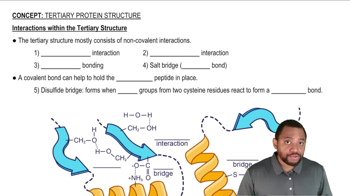Interactions of amino acids on the interior of proteins are key to the shapes of proteins. In group (a), which pairs of amino acids form hydrophobic interactions? In group (b), which pairs form ionic interactions? Which pairs in group (c) form hydrogen bonds?
a. 1 Pro . . . Phe
2 Lys . . . Ser
3 Thr . . . Leu
4 Ala . . . Gly






